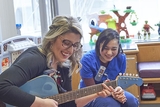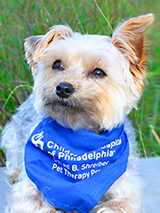
When a child is in the hospital, it’s vital that they still experience the joys of being a kid. The specially trained staff members of the Creative Arts Therapy Program and the Gerald B. Shreiber Pet Therapy Program at Children’s Hospital of Philadelphia provide innovative ways to make the hospital experience more manageable. Because these services are not covered by insurance, philanthropic gifts from countless donors power these programs. Each and every day, donors create brighter lives.

Creating art and making music allow hospitalized children to cope with stress, connect with others and express themselves. CHOP’s master’s-trained creative arts therapists work with patients and their siblings, providing opportunities to write and sing songs, make art, listen to and make music, and explore their creativity. “It’s an incredible privilege to help a child take all the ideas and all the feelings in their head and channel them into something,” says Mike Mahoney, MA, MT-BC, a music therapist in the Cancer Center. One leukemia patient, Jake, would light up when Mahoney visited his room. While playing the drums and electric guitar during his music therapy sessions, Jake could connect with happy memories of making music with his brother at home.
More wagging tails
For a child dealing with an illness or injury, a visit from an affectionate, happy dog transforms their day. “You can be miserable,” explains patient Kaylynn, putting her hand low to the ground to represent that mood. But if a dog shows up: “You’re happy!” Her hand shoots up above her head. “And the happy outweighs the miserable.”

Donors Patrice and Irv Rubin feel strongly about pet therapy, as it combines their interests in animals, children and healthcare. “It’s magical to see the smiles from everybody when the dogs show up,” says Patrice. In making their estate plan, they chose to leave half to CHOP’s Pet Therapy Program.
The pet therapy program has grown over the past 10 years, from 15 dogs to 75 dogs. The program has also added a full-time therapy dog named Dilly to accompany a staff child life specialist — a wonderful opportunity made possible by funding from the Dunkin’ Joy in Childhood Foundation and the Hope in the Air Foundation.
‘He’s just like me’
In some cases, the bond between certain dogs and patients is especially poignant. For example, visits from Cyrus, a small dog born without front legs, can reassure children with physical differences. “When I bring Cyrus to meet patients in the hospital, I often hear people say, ‘If he can do it, I can do it,’ or ‘He’s just like me,’” says Domenick, Cyrus’ owner.
Dogs with craniofacial defects — like Malikai, a golden retriever who underwent cleft palate repair — help patients embrace facial differences. “They’re going through the same things as many of us did, but without a care in the world,” says Danny, a patient treated by the Craniofacial Program in the Division of Plastic and Reconstructive Surgery. “They know how to live in the here and the now. It shows me that I’m not alone and reminds me to stay strong.”
When a child is in the hospital, it’s vital that they still experience the joys of being a kid. The specially trained staff members of the Creative Arts Therapy Program and the Gerald B. Shreiber Pet Therapy Program at Children’s Hospital of Philadelphia provide innovative ways to make the hospital experience more manageable. Because these services are not covered by insurance, philanthropic gifts from countless donors power these programs. Each and every day, donors create brighter lives.

Creating art and making music allow hospitalized children to cope with stress, connect with others and express themselves. CHOP’s master’s-trained creative arts therapists work with patients and their siblings, providing opportunities to write and sing songs, make art, listen to and make music, and explore their creativity. “It’s an incredible privilege to help a child take all the ideas and all the feelings in their head and channel them into something,” says Mike Mahoney, MA, MT-BC, a music therapist in the Cancer Center. One leukemia patient, Jake, would light up when Mahoney visited his room. While playing the drums and electric guitar during his music therapy sessions, Jake could connect with happy memories of making music with his brother at home.
More wagging tails
For a child dealing with an illness or injury, a visit from an affectionate, happy dog transforms their day. “You can be miserable,” explains patient Kaylynn, putting her hand low to the ground to represent that mood. But if a dog shows up: “You’re happy!” Her hand shoots up above her head. “And the happy outweighs the miserable.”

Donors Patrice and Irv Rubin feel strongly about pet therapy, as it combines their interests in animals, children and healthcare. “It’s magical to see the smiles from everybody when the dogs show up,” says Patrice. In making their estate plan, they chose to leave half to CHOP’s Pet Therapy Program.
The pet therapy program has grown over the past 10 years, from 15 dogs to 75 dogs. The program has also added a full-time therapy dog named Dilly to accompany a staff child life specialist — a wonderful opportunity made possible by funding from the Dunkin’ Joy in Childhood Foundation and the Hope in the Air Foundation.
‘He’s just like me’
In some cases, the bond between certain dogs and patients is especially poignant. For example, visits from Cyrus, a small dog born without front legs, can reassure children with physical differences. “When I bring Cyrus to meet patients in the hospital, I often hear people say, ‘If he can do it, I can do it,’ or ‘He’s just like me,’” says Domenick, Cyrus’ owner.
Dogs with craniofacial defects — like Malikai, a golden retriever who underwent cleft palate repair — help patients embrace facial differences. “They’re going through the same things as many of us did, but without a care in the world,” says Danny, a patient treated by the Craniofacial Program in the Division of Plastic and Reconstructive Surgery. “They know how to live in the here and the now. It shows me that I’m not alone and reminds me to stay strong.”